Displaying items by tag: Helmsmans Championships
Can Ger Owens Make It Three-In-A-Row Defending National Overall Helm Title In Mermaids At Foynes This Weekend?
It’s not the first time that the organisers of the National Championships of Champions have found themselves playing footsie with volatile Autumn weather.
Ten days ago, the National Junior Championship at Schull was cancelled due to southerly gales. And last year, the GP 14s’ representative Ger Owens found himself and his crew Mel Morris, retaining the trophy in an extremely intense one-day programme at Sutton Dinghy Club, as it was abundantly clear that any attempt at a second day of racing would be blown clean away.
Thus, meteorological fingers are crossed for this coming weekend (7th – 8th October), when the famously hospitable Foynes Yacht Club on the Shannon Estuary are staging the event in 17ft Mermaids. The Mermaids first appeared in 1932, and have been a significant presence in Irish sailing since 1936, so it isn’t the first time they’ve been used as the championship boat. For we happen to know for certain that in the 1965 Championship at Skerries in Mermaids, the winner was one James Nixon of Dublin University SC, and doubtless other sailing clans can make similar claims.
 An immaculately-prepared Mermaid from the Foynes fleet racing in the Shannon Estuary. Photo: Tony Quinlivan
An immaculately-prepared Mermaid from the Foynes fleet racing in the Shannon Estuary. Photo: Tony Quinlivan
But few of them can claim that their man or woman was going at it to make it three in a row, so it will be very interesting indeed to see how Owens shapes up out of his current comfort zone of the GP 14s. Experience suggests that he is multi-talented in the helming front. Meanwhile, those who are concerned about delays while the weather makes its mind up can be consoled by the fact that the sailors can otherwise occupy themselves with the flight simulator at the Foynes Flying Boat Museum near the club. Your correspondent once had a go at it, and managed to crash the Boeing 314 Clipper before he’d got beyond the simulated Loop Head.
Entry List 2023:
ILCA 7 Finn Lynch National YC Paris Olympic qualification place for Ireland
 All Ireland Sailing - 2023 Entry List
All Ireland Sailing - 2023 Entry List
Only in Ireland Could the Supreme Sailing Championship Produce Such Diverse Contenders
Only in Ireland could it be like this. We hear that of many things in this curious island of ours. But the varying sailing, location and personal backgrounds of the sixteen helmspersons competing in this weekend’s All-Ireland Helmsmans Championship at the National Yacht Club in Dun Laoghaire really does bring it all home. The Irish Sailing community is a very odd and idiosyncratic bunch - there’s no doubt about it – and their interests afloat and ashore are many, with the Select Sixteen reflecting this.
Plus that, we could comfortably devote an entire blog to the stories of the many different classes which have produced their representatives of national standard to compete for the big salver in Dun Laoghaire’s Flying Fifteen this morning, without devoting a single word to what those people are, and how they got to be top of their particular sailing pyramid.
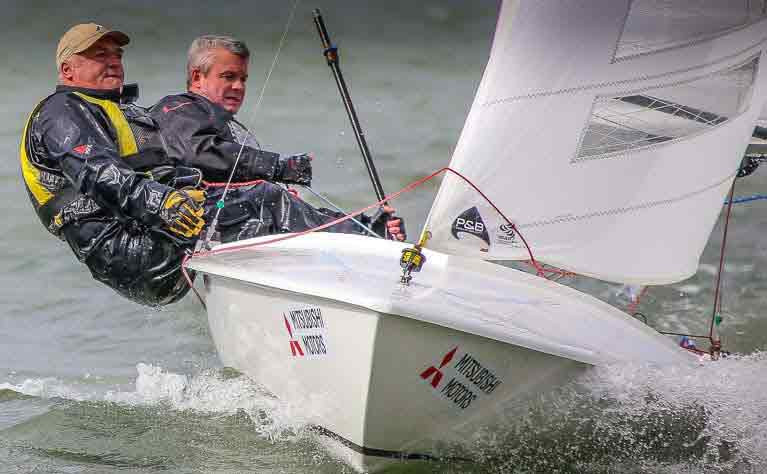 They’ve drawn the short straw….crew Chris Doorly (left) and helm Dave Gorman are in the uniquely demanding position of current Irish Champions in the Flying Fifteen Class, the boat of choice for this weekend’s All-Irelands at the National Yacht Club in Dun Laoghaire. Photo: Afloat
They’ve drawn the short straw….crew Chris Doorly (left) and helm Dave Gorman are in the uniquely demanding position of current Irish Champions in the Flying Fifteen Class, the boat of choice for this weekend’s All-Irelands at the National Yacht Club in Dun Laoghaire. Photo: Afloat
For sailing is first and foremost a vehicle sport, and it’s a distinctly oddball sailor who is not at least slightly fascinated by the boats he or she sails, and their potential for improvement. Yet while being something of an intelligent boat nerd undoubtedly helps, it’s the realisation that sheer sailing talent and having the right mind-set which gives that edge in the heat of competition, and it has been fascinating to see how top helms from other classes have been carefully picking crews to ensure that they’re better armed to take on the established skills of Flying Fifteen National Champions.
We ran the provisional list last week in giving a 72-year history of the event, but this morning’s up-to-date entry lineup shows some fine-tuning of personnel which adds an extra spice to the championship.
|
Helm |
Class |
Club |
Crew Name |
|
Cathy MacAleavey |
Water Wags |
National Yacht Club |
Con Murphy |
|
Robert Espey |
RS400 |
Ballyholme Yacht Club |
Stephen Milne |
|
David Gorman |
Flying Fifteen |
National Yacht Club |
Chris Doorly |
|
Sean Craig |
Laser Radial |
Royal St. George Yacht Club |
Alan Greene |
|
Peter Kennedy |
2018 Champion (SB20) |
Strangford Lough Yacht Club |
Stephen Kane |
|
Darren Wright |
ICRA IRC 2 |
Howth Yacht Club |
Matt Alvarado |
|
Rory Fekkes |
ICRA IRC 3 |
Carrickfergus Sailing Club |
Paul Fekkes |
|
Jonathan Horgan |
Shannon One Design |
Lough Derg Yacht Club |
Carden Kent |
|
John Sheehy |
Team Racing |
Royal St. George Yacht Club |
Darragh O'Connor |
|
Ronan Wallace |
Laser Standard |
Wexford Harbour Boat & Tennis Club |
Brendan Wallace |
|
Michael O'Connor |
SB20 |
Royal St. George Yacht Club |
Davy Taylor |
|
Gordon Patterson |
Squib |
Royal North of Ireland Yacht Club |
Ross Nolan |
|
Paddy Dillon |
Mermaids |
Rush Sailing Club |
Johnny Dillon |
|
Shane MacCarthy |
GP14 |
Greystones Sailing Club |
Stephen Boyle |
|
Colm O'Flaherty |
J24 |
Sligo Yacht Club |
Dave O'Connor |
|
Wyatt Orsmond |
Multihull IMA |
Swords Sailing Club |
Patrick Billington |
Yet with the boats being raced without the use of spinnakers, an inherent advantage of Flying Fifteen experience is removed at a stroke. And in any case, as pointed out last week, in racing against defending Helmsmans Championship title-holder Peter Kennedy of Strangford Lough with regular crew Stephen Kane, Gorman is up against a top SB 20 sailor who has Flying Fifteen sailing skill in his genes, as Peter’s parents Terence and Bridget were Flying Fifteen British Champions in 1962 (when that was the class’s main title), and his home club of Strangford Lough YC is imbued with a history of Flying Fifteen success, the most memorable being Bill Carson who became a world champion.
It puts extra pressure on National F/F Champion Dave Gorman of the home club with regular crewman Chris Doorly, for in this 50th year of the Flying Fifteen class in Dun Laoghaire - with the F/F Worlds 2019 staged by the club in Dublin Bay in September - the spotlight is on the Gorman/Doorly combo three times over.
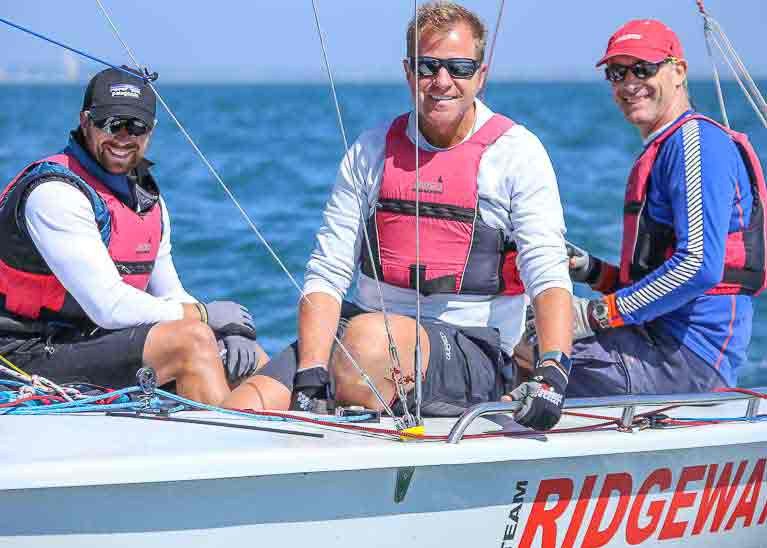 Olympian Peter Kennedy (right) after winning the SB 20 Nationals in Dun Laoghaire in June 2018 which provided his route into the 2018 All-Ireland at Lough Ree (in SB 20s) in October, which he duly won, and now like his parents he’s racing a Flying Fifteen to defend the title
Olympian Peter Kennedy (right) after winning the SB 20 Nationals in Dun Laoghaire in June 2018 which provided his route into the 2018 All-Ireland at Lough Ree (in SB 20s) in October, which he duly won, and now like his parents he’s racing a Flying Fifteen to defend the title
As it happened, Bill was the agent for that curious baked-plastic wood substitute Tufnol. In order to demonstrate its versatility, he built a Flying Fifteen entirely in Tufnol, and sailed the boat (called Ffreek) so well that be won the 1958 trophy. The usual armchair pundits were somewhat sniffy about this promotion of Tufnol as being arguably a professional entry, but the years have passed, and now it’s only remembered that 61 years ago, Bill Carson of Whiterock won the big championship in the Flying Fifteens in a Tufnol boat, while the comparable successes of others have been long forgotten.
Past success is not something which is forgotten with the sole woman contender, Cathy MacAleavey, who is being crewed by her husband Con Murphy. This is a formidable combination, and as they had a period of “very enjoyable” racing with the Dun Laoghaire Flying Fifteen fleet, they bring a special element of boat knowledge to add to their other multiple experience which includes Olympic participation in 1988 by Cathy and a Round Ireland Record together with Steve Fossett on the 60ft trimaran Lakota in 1993 – a superb record which stood for years.
Another family-flavoured entry is drawn from the ICRA ranks with Rory Fekkes of Carrickfergus SC being crewed by his father Paul, who was GP 14 World Champion with Rory’s uncle Mark in 1991 when they sailed for East Antrim Boat Club in Larne.
The Fekkes originally were a Dutch family who provided the crew on one of those characterful little Dutch freight-carrying coasters which were a common sight on the coasts of Europe until containerisation changed the structure of shipping completely. But before that happened, the first Fekkes came into Larne on their little ship the Noah in the 1960s, and simply decided to stay.
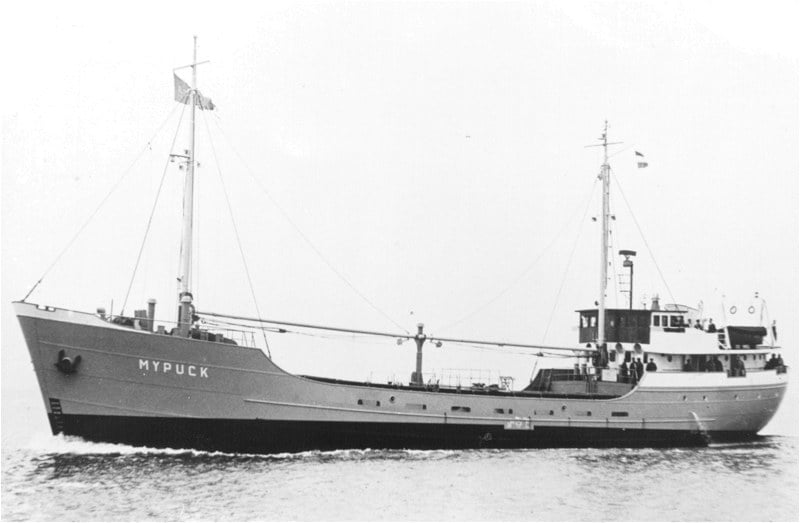 Classic Dutch coaster of the 1940s to ’70s – the head of Fekkes family arrived into Larne aboard one called Noah in the 1960s, and decided to stay Photo: Afloat
Classic Dutch coaster of the 1940s to ’70s – the head of Fekkes family arrived into Larne aboard one called Noah in the 1960s, and decided to stay Photo: Afloat
Now, sixty years later and with a new generation moving centre stage, Paul and his young son Rory bought a bog-standard Beneteau First 8 in Greystones and souped her up to a very high level, even going so far as to paint her black so folk might think she’s carbon fibre throughout….
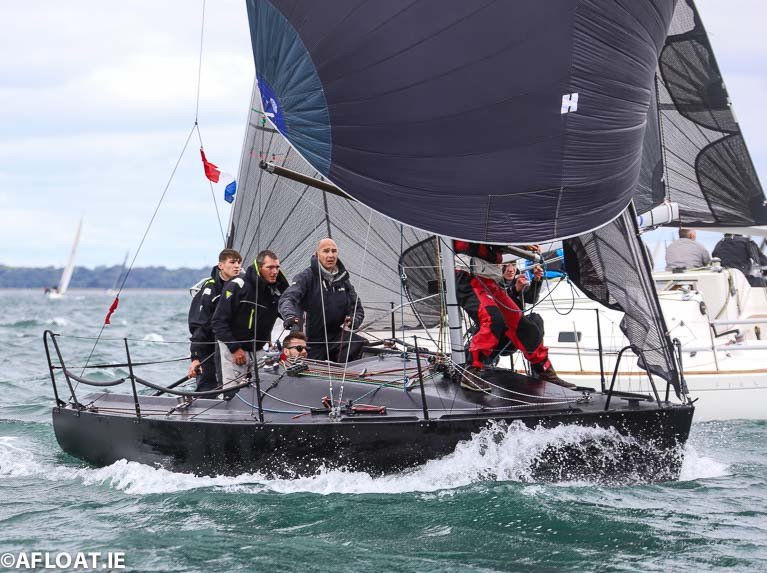 The Fekkes team on their way to success aboard F’n Gr8, with Rory (left) on helm and father Paul (centre) maintaining a tactical overview. Photo Afloat.ie/David O’Brien
The Fekkes team on their way to success aboard F’n Gr8, with Rory (left) on helm and father Paul (centre) maintaining a tactical overview. Photo Afloat.ie/David O’Brien
Whatever the colour, the memorably-named F’n Gr8 was always at the sharpest part of the sharp end of IRC 3 in Scotland, Cork and Dublin Bay during the 2019 season, and while the move into Flying Fifteens will be depriving Rory Fekkes of the advantages in racing a boat of which he knows every cubic millimetre, a sage observer of the County Antrim sailing scene tells us that having Paul Fekkes as your crew is always good for an extra percentage of boat speed and an added injection of sound tactics, and the dynamics of the sailing relationship in the Fekkes son-and-father combo is a wonder to behold.
Also from Belfast Lough, this time from the south shore, are the Squib Class National Champion (and many other 2019 Squib championships) Gordon Patterson of RNIYC Cultra, who reached the top this past summer sailing the 50-year-old Fagan crewed by Ross Nolan, and they’ll be together again this weekend.
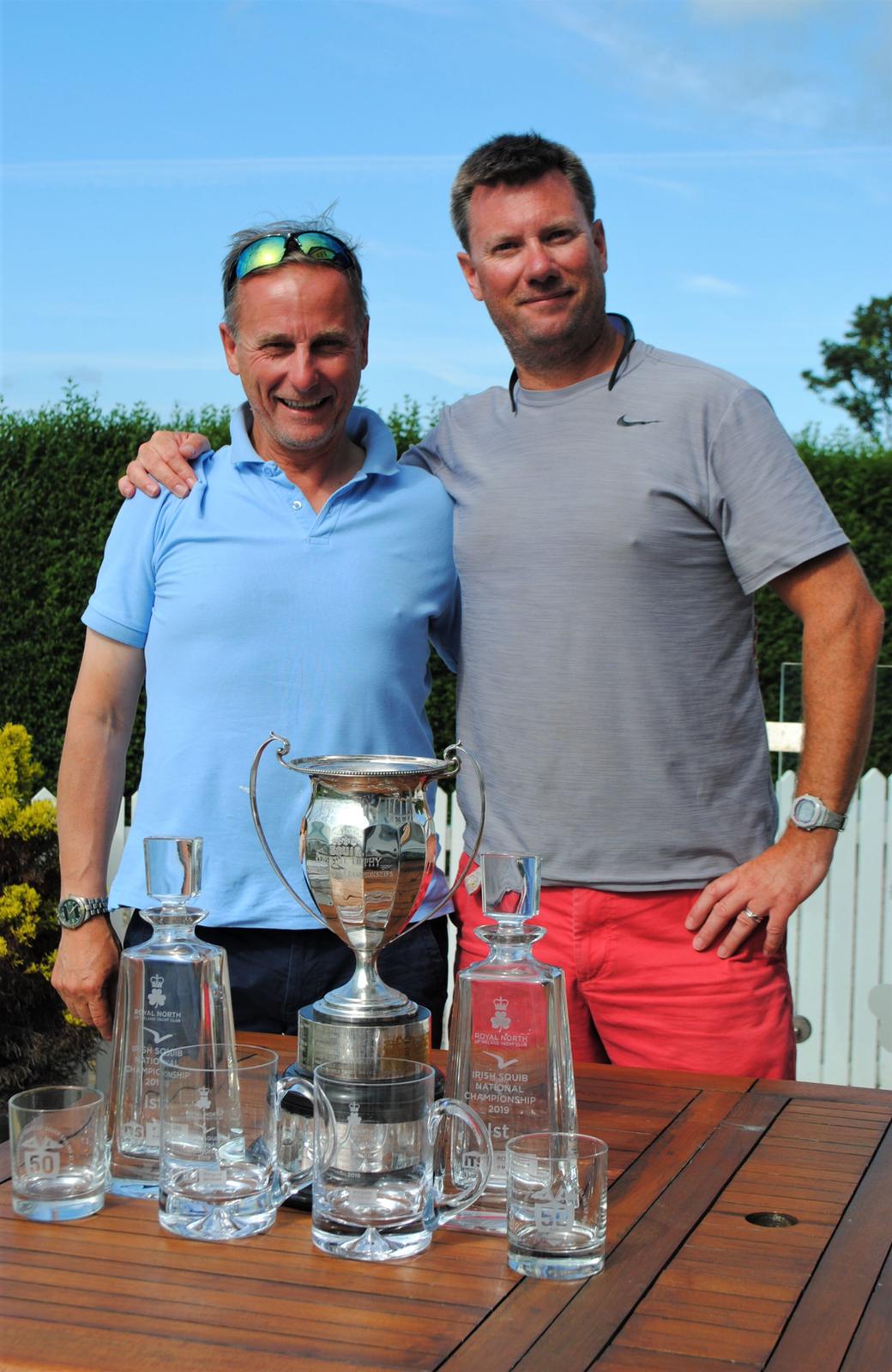 Gordon Patterson and Ross Nolan, overall Squib champions in the 50-year-old Fagan (RNIYC)
Gordon Patterson and Ross Nolan, overall Squib champions in the 50-year-old Fagan (RNIYC)
Cultra also saw success for Rob Espey and Stephen Milne of Ballyholme, who raced in the big-fleet RS 400 British & Irish Championships at RNIYC in August, and came second overall and Irish National Champions while they were at it. So after Chris and Olin Bateman won the Junior Championship last weekend in Schull with Chris being in it on the strength of his RS 200 National title, it will be interesting to see how the big brothers from the fast-moving RS 400 transfer to the more sedate yet tactics-and-technique-laden world of Flying Fifteen racing at national and senior level.
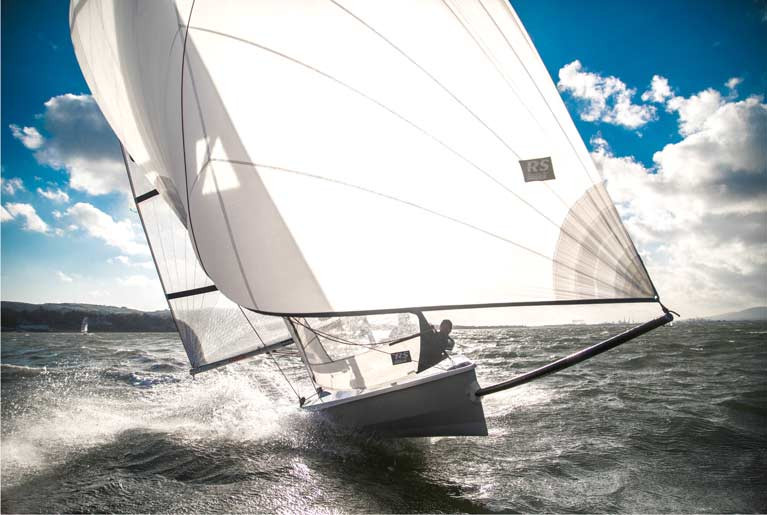 RS 400 in full flight on Belfast Lough, where Rob Espey of Balyholme won the Irish National title at Cultra
RS 400 in full flight on Belfast Lough, where Rob Espey of Balyholme won the Irish National title at Cultra
For make no mistake about it, the level is very high in this weekend series with the popular GP 14 class making a remarkable input, as there are two former GP 14 World Champions taking part. Paul Fekkes won it in 1991, while Shane MacCarthy of Greystones won it in 2016. McCarthy has added the 2019 Irish GP 14 title to his trophy list racing with Damian Bracken at Skerries, but for this weekend’s racing in Dublin Bay he has recruited Stephen Boyle, who formerly raced Flying Fifteens with success with Sean Craig.
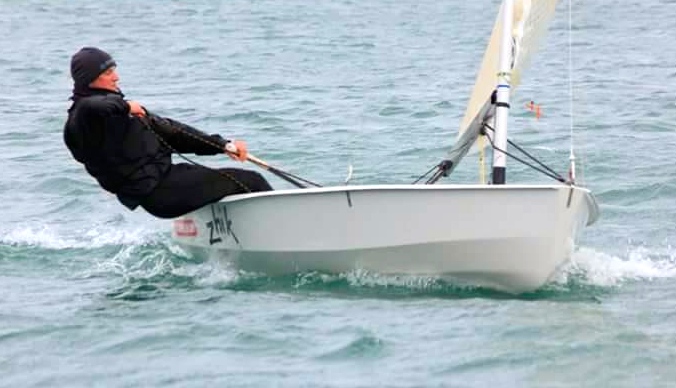 Shane MacCarthy racing his Solo. In addition to successfully racing GP 14s, Shane McCarthy has also been on the podium in the big-fleet season-long multi-location Solo Series in England, placing third overall.
Shane MacCarthy racing his Solo. In addition to successfully racing GP 14s, Shane McCarthy has also been on the podium in the big-fleet season-long multi-location Solo Series in England, placing third overall.
Shane MacCarthy has another sailing life entirely as a top helm in the attractive Solo single-hander – he has placed third overall in the well-supported season-long Solo series in England this year, and meanwhile Sean Craig – having been champion helm in 1993 at Larne in GP14s – is in the mix this weekend as the Laser Radial representative, and he has brought in F/F ace Alan Greene as crew to give a formidable boost to his chances.
 Sean Craig of Dun Laoghaire with the Salver in 1993, when he won it racing in GP 14s at Larne. He’s back this year as Laser Radial champion
Sean Craig of Dun Laoghaire with the Salver in 1993, when he won it racing in GP 14s at Larne. He’s back this year as Laser Radial champion
Also busy on the rockstar recruitment trail has been the IRC 4 and Irish Half-Ton Champion Darren Wright from Howth, who has professional form in this rockstar lineup business, as anyone who saw the nightly shows he laid on at the Howth Wave regatta event in 2018 will readily attest. For this weekend, he has hit the bullseye by hauling in Matt Alvarado – Bronze Medallist at the F/F Worlds last month – to operate the front end of the boat and help with calling the shots.
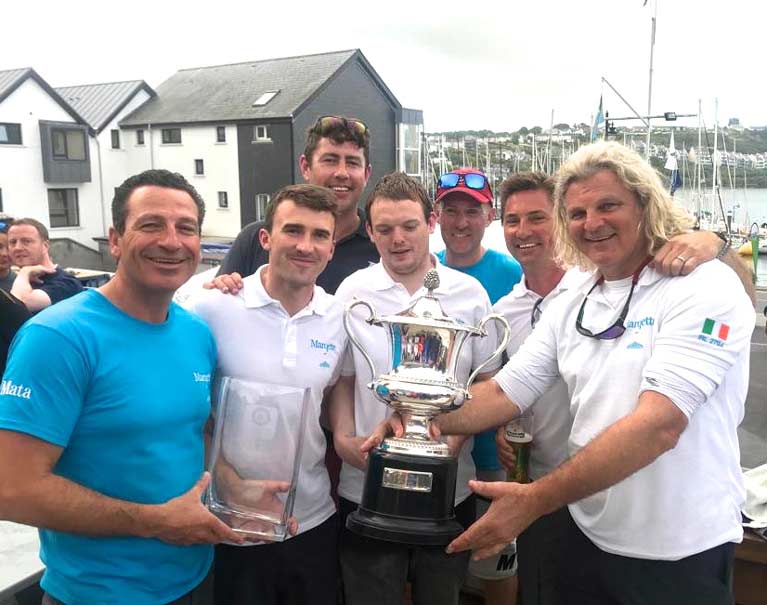 Helmsman Darren Wright of Howth (left) with the crew of Mata after winning the Irish Half-Ton Championship in Kinsale in June. For the Helmsman's Championship in Flying Fifteens, he has recruited Matt Alvarado (Bronze Medallist in F/F Worlds 2019) as crew
Helmsman Darren Wright of Howth (left) with the crew of Mata after winning the Irish Half-Ton Championship in Kinsale in June. For the Helmsman's Championship in Flying Fifteens, he has recruited Matt Alvarado (Bronze Medallist in F/F Worlds 2019) as crew
As defending champion Peter Kennedy emerged from the SB 20s last year, this growing class – with the effervescent John Malone from Lough Ree YC as new top honcho – should never be underestimated, particularly as their representative Michael O’Connor of Royal St George can include the SB20 World Corinthian Champion in his CV.
All these and most of the other contenders come from the familiar world of mono-hulls, but the Irish Multihull Association is making its pitch in the interesting person of Wyatt Orsmond, who is another life is Mr Eva Orsmond, consort of the TV personality. But despite living in Greystones, he does his main multi-hull racing to championship title level with Swords Sailing Club on the Broadmeadow Water in Fingal, and his crew this weekend in Dun Laoghaire will be Patrick Billington from Wicklow, which seems to suggest that multiple locations are an integral part of multihull racing.
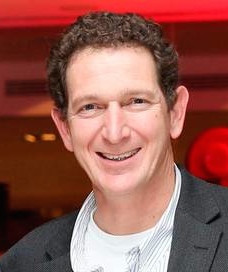 Wyatt Orsmond, helm for the Irish Multihull Association
Wyatt Orsmond, helm for the Irish Multihull Association
So in all it’s a lineup well reflective of modern Irish sailing life, and half a dozen helms and maybe more are certainly in there with a shout. As to the expected weather, what can we say in the aftermath of Storm Lorenzo?
When he was a Fisheries Inspector for the unofficial Provisional Government set up by Sinn Fein in Dublin’s Mansion House in 1919, global circumnavigator O’Brien patrolled the west coast of Connacht in his ketch Kelpie, and he was wont to observe of the utterly barren north end of the Mullet Peninsula in northwest Mayo that it was so devoid of any distinguishing features that it scarcely constituted a coastline at all, and left any observers in a very bewildered frame of mind.
So although Lorenzo was going fine until he got off that north end of Mullet, the very place seemed to cause him to collapse in on himself. Seldom can a post-tropical storm have evaporated so quickly. Maybe his strength was sucked away somehow by the nearby presence of the Corrib Gas Field.
Whatever, weather prediction is a doubly-cautious business at the moment, but with any luck the 2019 Irish Sailing All-Ireland Helmsman’s Championship at Dun Laoghaire will enjoy a southerly breeze today (Saturday), albeit with a spot of rain, and a clearer nor’westerly wind tomorrow which may fade as the day goes on, but we’ve no doubt the Dun Laoghaire machine will function efficiently to put through what promises to be a fascinating programme.































































